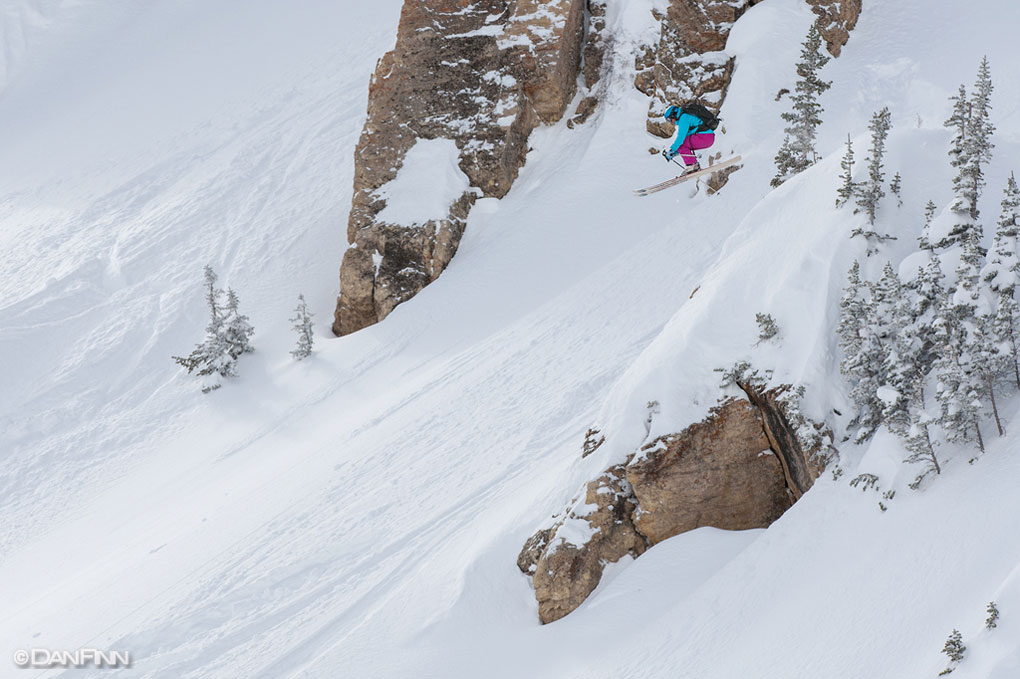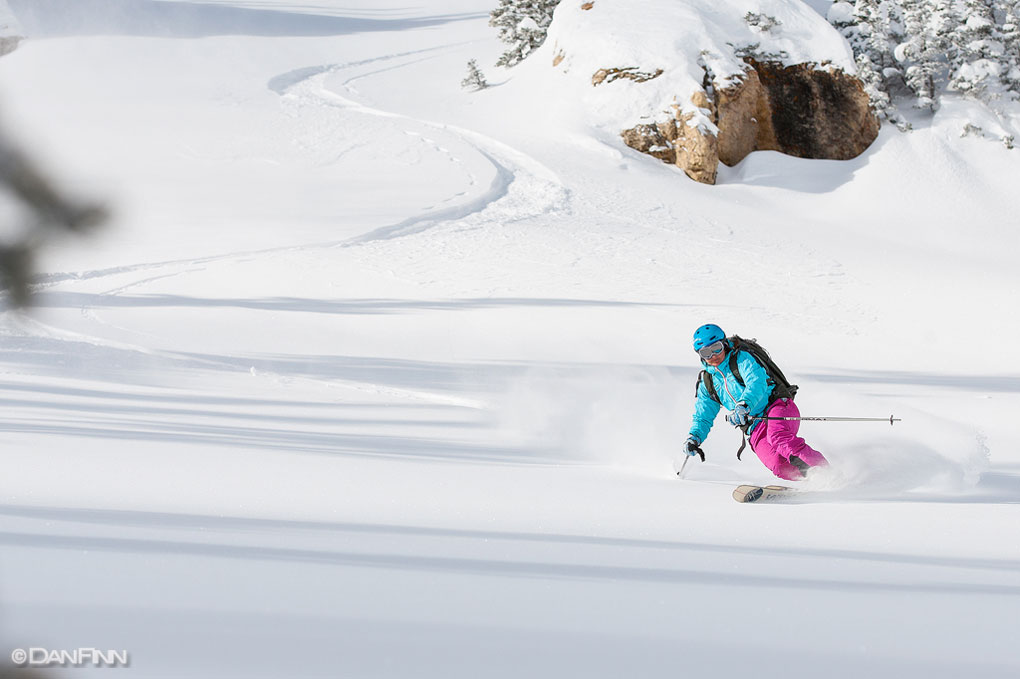Touring / Backcountry
Lightweight backcountry skis don’t often excite me in terms of their shape and design. Because it seems like so many companies offer the same thing—flat tail, rocker, stiff flex, etc.—I have spent most of my backcountry days on freeride-oriented skis instead, which are often more playful and surfy. With Surface, I was glad to see a company who is new to the backcountry scene already adding their own freeride flair to what a backcountry ski can be.

I really noticed this when I was lucky to get a few solid bc days on the Live Free’s shortly after a big storm. The snow had settled a lot, and a denser layer had fallen on top, so there was less blower pow and more creamy backcountry perfection, conditions in which the Live Free’s shone: just enough early rise to keep your tips up, but powerful and smooth.
I was also reminded of how nice and light the skis were. The freeride skis I usually take into the backcountry are often quite heavy. The light weight of the Live Free (relative to their size), was an immediate relief, both under my feet while skinning and on my back when bootpacking. The camber, especially leading into the tail, also helps skinning on firmer snow. After so many years of skinning on flat cambered skis, I had forgotten how much of a difference a little camber can make on the up when it is tricky skinning.
And on the descent, I’ve come across a number of different backcountry conditions. In settled, untracked powder, the Live Free skied beautifully and were smooth, powerful, and reliable.

In some of the more tricky conditions—especially in narrower chutes, with punchy, terrible snow—they were occasionally tough to maneuver; this was the only scenario where I felt their length to be a bit of a hinderance. But they were still light enough to make some hop turns if needed, and were not phased by chunder or crust. And again, the mid-fat waist meant that the ski got on edge fairly easily when conditions were firm.
Bottom Line
The Surface Live Free is a great choice if you’re looking to charge through everything from new snow to tough conditions in the backcountry, thanks in large part to their freeride-influenced design of slight rocker and stiff flex. They are reliable, sturdy, fast, but not too planky.
While they are also a decent resort ski, I wouldn’t make them my first choice if you plan on spending most of your time inbounds, especially if you stick to groomers and bumps. But if you are an advanced or expert skier who wants a lightweight backcountry tool that can handle a variety of conditions inbound and out, the Live Free is definitely one-ski quiver material.

Hello, after spending several days reading countless reviews on your site and being very impressed with the level of knowledge about skis I thought I would ask for your help. I am looking for a new pair of skis to use for Ski Patrol. Surface makes a pair for Patrolers called Save Life but I cannot find any reviews on them. I have a pair of frontside skis that I am happy with but want something more versital, something better for heavy PNW snow but can still hold a carved turn on the groomers. After reading many reviews two skis that seem interesting to me are the new Soul 7 and the 185 Cochise. I bought a used pair of of 195cm Pro XXL last year, hated them, too much work, they just wanted to be pointed down the fall line and go fast, I like to go fast, but prefer more turns to less. I am 6’1″ tall, 180lbs, strong skier that loves the whole mountain.
Hey, Jonathan – thanks for the kind words. Either ski could work. My only concern is how well the Soul 7 will handle deep, tracked, wet pow at speed. In untracked, I’d imagine you’ll love them, and they’ll be a million times easier to ski than your XXLs. The Cochise is a great chop & crud ski, but it’s not a “floaty” ski – but maybe that’s okay. Some other skis to consider: Blizzard Gunsmoke; 190cm Moment Deathwish; LINE Sick Day 110; ON3P Jeffrey or Vicik (though we haven’t reviewed these yet). Check out those reviews, and we’ll do our best to answer any further questions. But if you still like the sound of the Soul 7 or Cochise, I wouldn’t try to talk you out of those. Just hoping to find the best fit for you.
Jonathan,
Thank you for your reply and insights. I wonder if you might have some thoughts about the Save Life ski, perhaps from its dimensions and shape, you might expect it to be similar to some other ski or likely to have certain strengths or weaknesses? I need to stick to considering Volkl, Rossignol, Dynastar, Blizzard, Nordica or Head skis, but can’t talk about why ;-) so actually trying to avoid reading too many good things about some of the other skis
Thanks again,
Jonathan Gibson
Summit Central Ski Patrol
Hello Jonathan, I was wondering if you could provide some input. Based on Kate’s review of the Live Free at 181 with -6cm mount. Was the -6cm BSC from the recommended 85cm? If so that would put BSC at 79cm and if assuming she uses a the BD boot with a center of around 130mm – 14.5mm duckbill pin, that would put her BSC add point at apporx. 115mm; or 11.5cm added to the BSC she marked on ski at 79cm. This would equate to 90.5cm for binding mounting point (pin line point). If this is close to her setup, then she should be running at about CenterCord CC (181/2 = 90.5). Unless the 181 ski pulls a cord-line of less than the 181cm claimed length due to tip and tail rise as with most skis. If so I would think that she set her bindings up at about +1cm of CC which should put BSC at -6cm of recommended Classic Alpine.
Can you tell me exactly where she set her bindings and her boot size? If I have that I can translate that calculation to my ski and see what the setup would be like.
I ask all this because I just drilled and mounted my Walk Free 186cm (cord length 184cm) skis based on advice from the guys over at Surface. They told me that their Tele Park guys like running 84.5cm from tail which is -2.5cm from Classic Alpine recommended (only setting for that ski). Based on the provided info and assuming that park guys stick to the Piste, I knew I needed some additional setback, as this ski will be my designated backcountry/wilderness ski. I set my skis at -3.25cm from recommended (approx. -1.25cm from Park Guys) and after one run I can’t stand them. I have skinned in them and the more centered mount point made that easy, but the down was the pits. I used them in 4’ wind effect fresh pockets on the northern edge of Brian Head resort the other day and they never felt right. Felt like I was over the bars one moment and pushing hard to control from the backseat the next. Needless to say they worked great on the Piste back to the truck to retrieve my 191 EHP’s. I ski the EHP’s closer to recommended mount point, but that is a very different bird from the walk free. For that fact the Live Free is a bit different too with the higher rocker and the tail rocker than the Walk Free. The Walk Free uses a more traditional square tail, but still has tip/tail rise.
Sorry for the long text, but I can’t stand making Swiss Cheese out of a new pair of skis and based on my assumptions of Kate’s Live Free mounting point being very close to CC; I’m wondering if I too should pull that far back. I don’t think I should go all the way to pins on CC, even though the ski has some traditional designing. I think I should play it safe and stay +1 to +2.5 of CC for pin line. If I have all her setup info that would show exactly where she put pin and I could go somewhere in there.
Other option is to pull my binding s before drilling the ski again and just move it while it still has value to someone else. After reading her review and two others, I think the 191 Live Free would have been the better choice. I generally ski 193-196cm and the 186 (unfortunately the longest length) feels rather tiny. Then again smaller skis are confidence inspiring when dealing with tight rocky backcountry spaces. I’m about 6.2 @ 240 and 49 years old football player build. I went with the Walk Free as first choice because I have the EHP’s for roadside backcountry access, but needed something more tour oriented, as my normal ski route has about a 7 mile, 2000’ gain one way trek to toe-of-slope from the truck; then the climbing begins.
If you can give me any info or if she can email me that would be a major help. Thank you, Ed
Hi Ed, this is probably too late, but 86,0cm (0,5 cm back from classic alpine) seems just fine for me on Walk Frees 186 with Dynafit Radical FT bindings and mainly BC skiing. I use wider Live Frees 191 for deeper days though, with same Dynafit bindings. Maybe for deep days Walk Frees could go on 84,5 as it was also suggested on last years edition of Surface mounting guidelines. This year they changed that, also for last year skis, so …
Just another opinion .. -6 is way to much for Live Frees. I tried those in several positions while on demo bindings last fall and figured out -3 is a sweet spot on those skis when talking BC skiing. More back = much less control and less float due shorter tails, more fwd = lack of forward float on deep days, but one can adapt to 0,0 if needed …